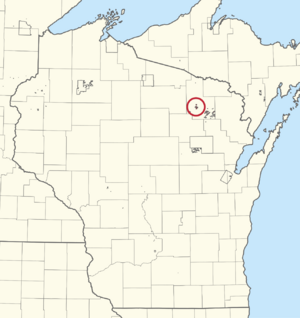Forest County Potawatomi Community facts for kids
| Total population | |
|---|---|
| 1,400 (2010) | |
| Regions with significant populations | |
| Languages | |
| English, Potawatomi | |
| Related ethnic groups | |
| other Potawatomi and Anishinaabe people |
The Forest County Potawatomi Community (in their language, Ksenyaniyek) is a group of Potawatomi people officially recognized by the United States government. As of 2010, about 1,400 people are members of this community.
Their home is the Forest County Potawatomi Indian Reservation in Wisconsin. This reservation is made up of several pieces of land. These lands are located in southern Forest County and northern Oconto County. The community also manages a small area of land in the city of Milwaukee. The main offices and cultural center are near Crandon, Wisconsin.
Contents
How the Potawatomi Community Thrives
The Forest County Potawatomi Community runs different businesses. These businesses help support the community and its members. They also help protect important cultural and natural resources.
Community Businesses and Casinos
The Forest County Potawatomi Community operates two casinos. These are the Potawatomi Hotel & Casino in Milwaukee and the Potawatomi Bingo Northern Lights Casino in Carter, Wisconsin. These businesses create jobs and bring money to the community.
Protecting the Environment: The Crandon Mine Story
The Potawatomi Community, along with the Sokaogon Chippewa Community, bought the old Crandon mine near Crandon. They did this to stop the mine from reopening. The tribes were worried that reopening the zinc and copper mine would harm the local environment. They wanted to protect the land and water for future generations.
Discovering Potawatomi Culture: The Cultural Center and Museum
The Forest County Potawatomi Cultural Center and Museum is a special place. It was created to teach everyone about the Potawatomi people's culture and traditions. It also helps pass these important traditions to younger generations.
What You Can Explore at the Museum
The Cultural Center is a place where people can gather and share stories. Both Native Americans and non-Native Americans are welcome to visit and learn. The museum has many unique and interesting exhibits. These exhibits were designed with help from community elders.
The main exhibit is called "The Long Walk." It tells the history of the Potawatomi people. This exhibit is in both the Potawatomi language and English. It has four main parts:
- The Long Walk: This section shares the history of the Potawatomi people.
- People Who Share a Language: An interactive screen where you can learn about the language.
- Traditional Ways: This part shows different traditional items and practices.
- Present Day Heritage: This display highlights the heritage of the tribe today.
Special Highlights of the Museum
The museum also features several unique displays:
- "People of the Three Fires": This is a large display that recreates the Council of Three Fires. It's located in the center of the exhibition.
- "The Gathering": A video that shows different Potawatomi communities across North America.
- "The Wall of Treaties": This wall displays copies of 43 treaties made with the United States. It also shows seven treaties made with Canada.
- "Wigwas Tthiman" (Birchbark Canoe): This amazing birchbark canoe was built right at the museum. Visitors could watch each step of the five-week building process. It shows traditional canoe-making methods.
Learning Traditional Skills
The Cultural Center also offers "Living History/Craft Classes." Throughout the year, the community offers classes on traditional skills. These include making moccasins, flutes, and dance regalia. You can also learn how to build model canoes, take language classes, and learn birch/quill and black ash basketry.


